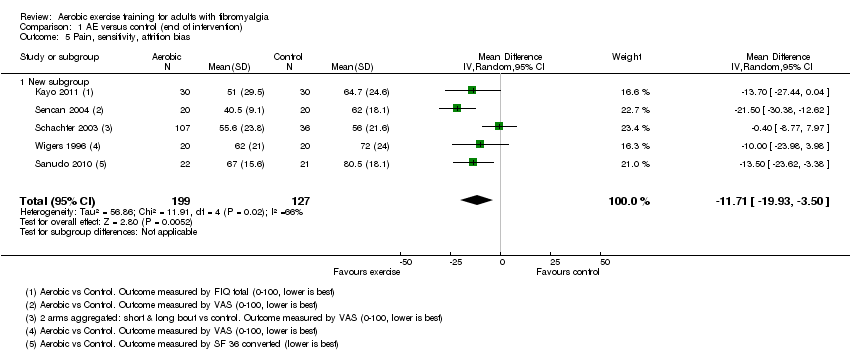| Author, year, intervention | Frequency, times per week – length in weeks | Intensity/ACSM intensity classification | Time/Duration/Session, minutes | Type/Mode |
| Aerobic vs control |
| Gowans 2001 | 3 times/wk | 23 weeks | 60%‐75% age‐adjusted HRmax
ACSM: low to moderate | 30' | Supervised water walking/running progressing to land walking/running |
| Kayo 2011 | 3 times/wk | 16 weeks | 40%‐50% HRR at week 1 to 60%‐70% HRR by week 16
ACSM: moderate at week 1 to vigorous by week 16 | ˜ 60' | Supervised indoor or outdoor walking |
| King 2002 | 3 times/wk | 12 weeks | 60%‐75% predicted HRmax
ACSM: light to moderate | Starting duration 10 to 15' progressing to 20 to 40' | Supervised walking, aquacise (deep and shallow water), or low‐impact aerobics |
| Mengshoel 1992 | 2 times/wk | 20 weeks | 120‐150 beats per minute ACSM: moderate to vigorous | 60' | Supervised low‐impact aerobic dance program |
| Nichols 1994 | 3 times/wk | 8 weeks | 60%‐70% predicted HRmax/age ACSM: light to moderate | Unclear | Supervised fast‐paced walking on an indoor track |
| Sanudo 2010 | 2 times/wk | 24 weeks | 60%‐65% HRmax (steady state aerobics) and 75%‐80% HRmax (interval training) ACSM: light to moderate and moderate to vigorous | 45‐60’ | Supervised aerobics including continuous walking with arm movements and jogging; interval training including aerobic dance and jogging |
| Schachter 2003 Short bout | 3 to 5 times/wk | 16 weeks | 40%‐50% HRR at week 1, 60%‐70% HRR by week 10 ACSM: moderate at week 1, vigorous by week 10 | 2/d, 5' at week 1 to 15'
at week 9 | Home program of low‐impact aerobics to videotaped instructor and music, rhythmical movements of lower body muscles. Supervision at 0, 4, 8, and 12 weeks |
| Schachter 2003 Long bout | 3 to 5 times/wk | 16 weeks | 40%‐50% HRR at week 1, 60%‐70% HRR by week 10 ACSM: moderate at week 1; vigorous by week 10 | 10' at week 1 to 30'
at week 9 | Home program of low‐impact aerobics to videotaped instructor and music, rhythmical movements of lower body muscles. Supervision at 0, 4, 8, and 12 weeks |
| Sencan 2004 Aerobic exercise | 3 times/wk | 6 weeks | Not specified | 40’ | Cycle ergometry. Supervision unclear |
| Wigers 1996 | 3 times/wk | 14 weeks | Tempo gradually increased up to, and decreased down from, 4 periods of 60%‐70% HRmax ACSM: light to moderate | 45’ | Supervised movement to music and games |
| Aerobic vs aerobic2 |
| Mannerkorpi 2010 AE: Nordic walking | 2 times/wk | 15 weeks | 10’ at RPE 9‐11 2' intervals of RPE 13‐15, alternated with 2' at RPE 10 to 11 ACSM: 10’ light, 2’ intervals moderate to vigorous alternated with 2’ light. | 20’ | Supervised walking in parks and forests with flat areas and small hills |
| Mannerkorpi 2010 AE2: low‐intensity walking | 1 time/wk | 15 weeks | RPE 9 to 11
ACSM: light | 20’ | Supervised walking in parks and forests with flat areas and small hills |
| Ramsay 2000. AE: exercise class | 1 time/wk | 12 weeks | Not specified | 60’ | Supervised graded circuit exercises consisting of step‐ups, sitting to standing, skipping, jogging on the spot, alternate side bends, circling arms with increasing weights, plus encouragement to continue and increase exercises at home |
| Ramsay 2000 AE2: single class | 1 session | 12 weeks | Not specified | 60’ | Demonstration of aerobic exercises, stretching and relaxation technique, plus written advice on aerobic exercises plus stretching and relaxation |
| Schachter 2003: AE: short bout | 3 to 5/wk | 16 weeks | 40%‐50% HRR at week 1, 60%‐70% HRR by week 10
ACSM: moderate at week 1, vigorous by weeks 10‐16 | 2/d 5' up to 15' | Home program of low‐impact aerobics to videotaped instructor and music, rhythmical movements of lower body muscles. Supervision at 0, 4, 8, and 12 weeks |
| Schachter 2003 AE2: long bout | 3 to 5/wk | 16 weeks | 40%‐50% HRR at week 1, 60%‐70% HRR by week 10 ACSM: moderate at week 1, vigorous by weeks 10‐16 | 10' up to 30' | Home program of low‐impact aerobics to videotaped instructor and music, rhythmical movements of lower body muscles. Supervision at 0, 4, 8, and 12 weeks |
| Aerobic vs other (education or stress management training) |
| Fontaine 2007 | Group session every 2 weeks AE: 5‐7 times/wk | 12 weeks | Moderate intensity ACSM: moderate
Review authors used appropriate references to help translate "moderate" into action | 10’ and increase daily 5’/wk to at least 30’ | Brisk walking and other modes of aerobic activity (+ group session/supervision) |
| Fontaine 2010 | 5‐7 times/wk | 12 weeks | Moderate (breathing heavily but able to keep a conversation) + 15’ of above usual level ACSM: moderate Review authors used appropriate references to help translate "moderate" into action | 60’ | Walking (the most common form of LPA) and other forms (eg, garden/mowing the lawn); household activity (eg, vacuuming); and sports activity (eg, cycling, swimming, field hockey) (+ group sessions/supervision) |
| King 2002 | 3 times/wk | 12 weeks | 60%‐75% predicted HRmax ACSM: light to moderate | Starting duration 10 to 15' progressing to 20 to 40' | Supervised walking, aquacise (deep and shallow water), or low‐impact aerobics |
| Sencan 2004 | 3 times/wk | 6 weeks | Not specified | 40’ | Cycle ergometry. Supervision unclear |
| Wigers 1996 | 3 times/wk | 14 weeks | Tempo gradually increased up to, and decreased down from, 4 periods at 60%‐70% HRmax ACSM: light to moderate | 45’ | Supervised movement to music and games |




































